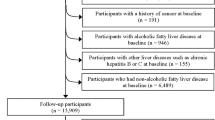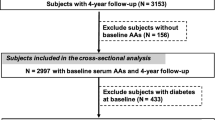Abstract
Purpose
Taurine (2-aminoethanesulfonic acid), a molecule obtained from diet, is involved in bile acid conjugation, blood pressure regulation, anti-oxidation and anti-inflammation. We performed the first prospective study of taurine and CHD risk.
Methods
We conducted a case–control study nested in the New York University Women’s Health Study to evaluate the association between circulating taurine levels and risk of coronary heart disease (CHD). Taurine was measured in two yearly pre-diagnostic serum samples of 223 CHD cases and 223 matched controls and averaged for a more reliable measurement of long-term taurine levels.
Results
Mean serum taurine was positively related to age and dietary intake of poultry, niacin, vitamin B1, fiber and iron, and negatively related to dietary intake of saturated fat (all p values ≤0.05). There was no statistically significant association between serum taurine levels and the risk of CHD in the overall study population. The adjusted ORs for CHD in increasing taurine tertiles were 1.0 (reference), 0.85 (95% CI, 0.51–1.40) and 0.66 (0.39–1.13; p for trend = 0.14). There was a significant inverse association between serum taurine and CHD risk among women with high total serum cholesterol (>250 mg/dL) (adjusted OR = 0.39 (0.19–0.83) for the third versus first tertile; p for trend = 0.02) but not among those with low total serum cholesterol (p for interaction = 0.01). The data suggest a possible inverse association of serum taurine with diabetes and hypertension risk.
Conclusions
The findings suggest that high levels of taurine may be protective against CHD among individuals with high serum cholesterol levels.
Similar content being viewed by others
References
AHA (2009) 2009 Update at-a-glance. American Heart Association, Dallas, pp 1–36
Mente A, de Koning L, Shannon HS, Anand SS (2009) A systematic review of the evidence supporting a causal link between dietary factors and coronary heart disease. Arch Intern Med 169:659–669
Visioli F, Hagen TM (2007) Nutritional strategies for healthy cardiovascular aging: focus on micronutrients. Pharmacol Res 55:199–206
Yamori Y, Nara Y, Ikeda K, Mizushima S (1996) Is taurine a preventive nutritional factor of cardiovascular diseases or just a biological marker of nutrition? Adv Exp Med Biol 403:623–629
Mizushima S, Moriguchi EH, Ishikawa P, Hekman P, Nara Y et al (1997) Fish intake and cardiovascular risk among middle-aged Japanese in Japan and Brazil. J Cardiovasc Risk 4:191–199
Huxtable RJ (1992) Physiological actions of taurine. Physiol Rev 72:101–163
Yamori Y, Liu L, Mizushima S, Ikeda K, Nara Y (2006) Male cardiovascular mortality and dietary markers in 25 population samples of 16 countries. J Hypertens 24:1499–1505
Yamori Y, Liu L, Ikeda K, Miura A, Mizushima S et al (2001) Distribution of twenty-four hour urinary taurine excretion and association with ischemic heart disease mortality in 24 populations of 16 countries: results from the WHO-CARDIAC study. Hypertens Res 24:453–457
Greenland S, Robins J (1994) Invited commentary: ecologic studies—biases, misconceptions, and counterexamples. Am J Epidemiol 139:747–760
Mizushima S, Nara Y, Sawamura M, Yamori Y (1996) Effects of oral taurine supplementation on lipids and sympathetic nerve tone. Adv Exp Med Biol 403:615–622
Zhang M, Bi LF, Fang JH, Su XL, Da GL et al (2004) Beneficial effects of taurine on serum lipids in overweight or obese non-diabetic subjects. Amino Acids 26:267–271
Liu L, Liu L, Ding J, Huang Z, He B et al (2001) Ethnic and environmental differences in various markers of dietary intake and blood pressure among Chinese Han and three other minority peoples of China: results from the WHO cardiovascular diseases and alimentary comparison (CARDIAC) study. Hepertens Res 24:315–322
Fujita T, Katsuyuki A, Noda H, Yasushi I, Sato Y (1987) Effects of increased adrenomedullary activity and taurine in young patients with borderline hypertension. Circulation 75:525–532
Wójcik O, Koenig KL, Zeleniuch-Jacquotte A, Costa M, Chen Y (2010) The potential protective effects of taurine on coronary heart disease. Atherosclerosis 208:19–25
Toniolo PG, Pasternack BS, Shore RE, Sonnenschein E, Koenig KL et al (1991) Endogenous hormones and breast cancer: a prospective cohort study. Breast Cancer Res Treat 18:S23–S26
Block G, Hartman AM (1989) Issues in reproducibility and validity of dietary studies. Am J Clin Nutr 50:1133–1138
Riboli E, Toniolo P, Kaaks R, Shore RE, Casagrande C et al (1997) Reproducibility of a food frequency questionnaire used in the New York University Women’s Health Study: effect of self-selection by study subjects. Eur J Clin Nutr 51:437–442
Rose GA, Blackburn H, Gillum RF, Prineas RJ (1982) Cardiovascular survey methods. World Health Organization, Geneva
Wójcik O, Koenig KL, Zeleniuch-Jacquotte A, Costa M, Chen Y (2010) Reproducibility of HPLC taurine measurements in frozen serum of healthy postmenopausal women. Br J Nutr 104:629–632
Al-Delaimy WK, Natarajan L, Sun X, Rock CL, Pierce JP, Women’s Healthy Eating and Living (WHEL) Study Group (2008) Reliability of plasma carotenoid biomarkers and its relation to study power. Epidemiology 19:338–344
Hunter D (1998) Biochemical indicators of dietary intake. In: Willett W (ed) Nutritional epidemiology, 2nd edn. Oxford University Press, New York, pp 174–243
Tcherkas YV, Kartsova LA, Krasnova IN (2001) Analysis of amino acids in human serum by isocratic reversed-phase high-performance lipid chromatography with electrochemical detection. J Chromatogr A 913:303–308
McNamara JR, Huang C, Massov T, Leary ET, Warnick GR et al (1994) Modification of the dextran-Mg2 + high-density lipoprotein cholesterol precipitation method for use with previously frozen plasma. Clin Chem 40:233–239
Kimberly MM, Leary ET, Cole TG, Waymack PP (1999) Selection, validation, standardization, and performance of a designated comparison method for HDL-cholesterol for use in the cholesterol reference method laboratory network. Clin Chem 45:1803–1812
Breslow N, Day NE (1980) Conditional logistic regression for matched sets. In: Davis W (ed) Statistical methods in cancer research vol 1 the analysis of case-control studies. IARC, Lyon, pp 248–279
Ito M (2004) The metabolic syndrome: pathophysiology, clinical relevance, and use of niacin. Ann Pharmacother 38:277–285
Woodside J, McKinley MC, Young IS (2008) Saturated and trans fatty acids and coronary heart disease. Curr Atheroscler Rep 10:460–466
Hu FB, Willett WC (2002) Optimal diets for prevention of coronary heart disease. JAMA 288:2569–2578
Renaud S, Lanzmann-Petithoty D (2001) Coronary heart disease: dietary links and pathogenesis. Public Health Nutr 4:459–474
Meyers D (1996) The iron hypothesis—does iron cause atherosclerosis? Clin Cardiol 19:925–929
Willett WC (1998) Nutritional epidemiology. Oxford University Press, New York, p 514
Finnegan D (2003) The health effects of stimulant drinks. Br Nutr Found Nutr Bull 28:147–155
Schuller-Levis GB, Park E (2003) Taurine: new implications for an old amino acid. FEMS Microbiol Lett 226:195–202
Holvoet P, Harris TB, Tracy RP, Verhamme P, Newman AB et al (2003) Association of high coronary heart disease risk status with circulating oxidized LDL in the well-functioning elderly: findings from the health, aging, and body composition study. Arterioscler Thromb Vasc Biol 23:1444–1448
Wu T, Willett WC, Rifai N, Shai I, Manson JE, Rimm EB (2006) Is plasma oxidized low-density lipoprotein, measured with the widely used antibody 4E6, an independent predictor of coronary heart disease among US men and women? J Am Coll Cardiol 48:973–979
Tan B, Jiang D, Huang H, Jia J, Jiang JL, Hu C, Li Y (2007) Taurine protects against low-density lipoprotein-induced endothelial dysfunction by the DDAH/ADMA pathway. Vasc Pharmacol 46:338–345
Matsushima Y, Sekine T, Kondo T, Kameo K, Tachibana M, Murakami S (2003) Effects of taurine on serum cholesterol levels and development of atherosclerosis in spontaneously hyperlipidaemic mice. Clin Exp Pharmacol Physiol 30:295–299
Laidlaw SA, Grosvenor M, Kopple JD (1990) The taurine content of common foodstuffs. J Parenter Enteral Nutr 14:183–188
Pasantes-Morales H, Quesada O, Alcocer L, Sánchez Olea R (1989) Taurine content in foods. Nutr Rep Int 40:793–801
Lourenço R, Camilo ME (2002) Taurine: a conditionally essential amino acid in humans? An overview in health and disease. Nutr Hosp 17:262–270
Kim ES, Kim KJ, Yim MH, Joeng Y, Ko YS, Watanabe T, Nakatsuka H, Nakatsuka S, Matsuda-Inoguchi N, Shimbo S, Ikeda M (2003) Dietary taurine intake and serum taurine levels of women on Jeju Island. Adv Exp Med Biol 526:277–283
Elizarova E, Nedosugova LV (1996) First experiments in taurine administration for diabetes mellitus—the effect of erythrocyte membranes. Adv Exp Med Biol 403:583–588
Koenig K, Toniolo P, Bruning P, Bonfrer J, Shore R, Pasternack B (1993) Reliability of serum prolactin measurements in women. Cancer Epidemiol Biomarker Prev 2:411–414
Martin L, Leff M, Calonge N, Garrett C, Nelson DE (2000) Validation of self-reported chronic conditions and health services in managed care populations. Am J Prev Med 18:215–218
Okura Y, Urban LH, Mahoney DW, Jacobsen SJ, Rodeheffer RJ (2004) Agreement between self-report questionnaires and medical record data was substantial for diabetes, hypertension, myocardial infarction and stroke but not for heart failure. J Clin Epidemiol 57:1093–1103
Acknowledgments
This research was supported by U.S. grants: NIH grants ES000260, CA16087, CA098661 and American Heart Association grant 0835569D. The authors thank Mr. Alan Bowers and Mrs. Yelena Afanasyeva for their involvement in the study.
Conflict of interest
The authors declare that they have no conflict of interest.
Author information
Authors and Affiliations
Corresponding author
Rights and permissions
About this article
Cite this article
Wójcik, O.P., Koenig, K.L., Zeleniuch-Jacquotte, A. et al. Serum taurine and risk of coronary heart disease: a prospective, nested case–control study. Eur J Nutr 52, 169–178 (2013). https://doi.org/10.1007/s00394-011-0300-6
Received:
Accepted:
Published:
Issue Date:
DOI: https://doi.org/10.1007/s00394-011-0300-6




